Corporate Finance Case Study: Risk Management at Air Canada
VerifiedAdded on 2023/05/28
|7
|1602
|309
Case Study
AI Summary
This case study examines the financial challenges faced by Air Canada, particularly during the 2009-2010 financial downturn, focusing on declining passenger volume and rising operating costs. The primary issue identified is the Board of Directors' insufficient contribution to effective risk management policies. Alternative solutions are explored, including improved coordination of risk management with strategic planning, revamping the business model, and aligning revenue maximization strategies with profit maximization. The recommended solution involves revamping the business model to integrate risk reduction strategies, such as decreasing account receivables, forwarding interest rate agreements, utilizing currency swaps, modifying insurance schemes, and enhancing technological backup, to improve overall financial performance. Desklib offers solved assignments and past papers for students.

Case Study Analysis
Paraphrase This Document
Need a fresh take? Get an instant paraphrase of this document with our AI Paraphraser
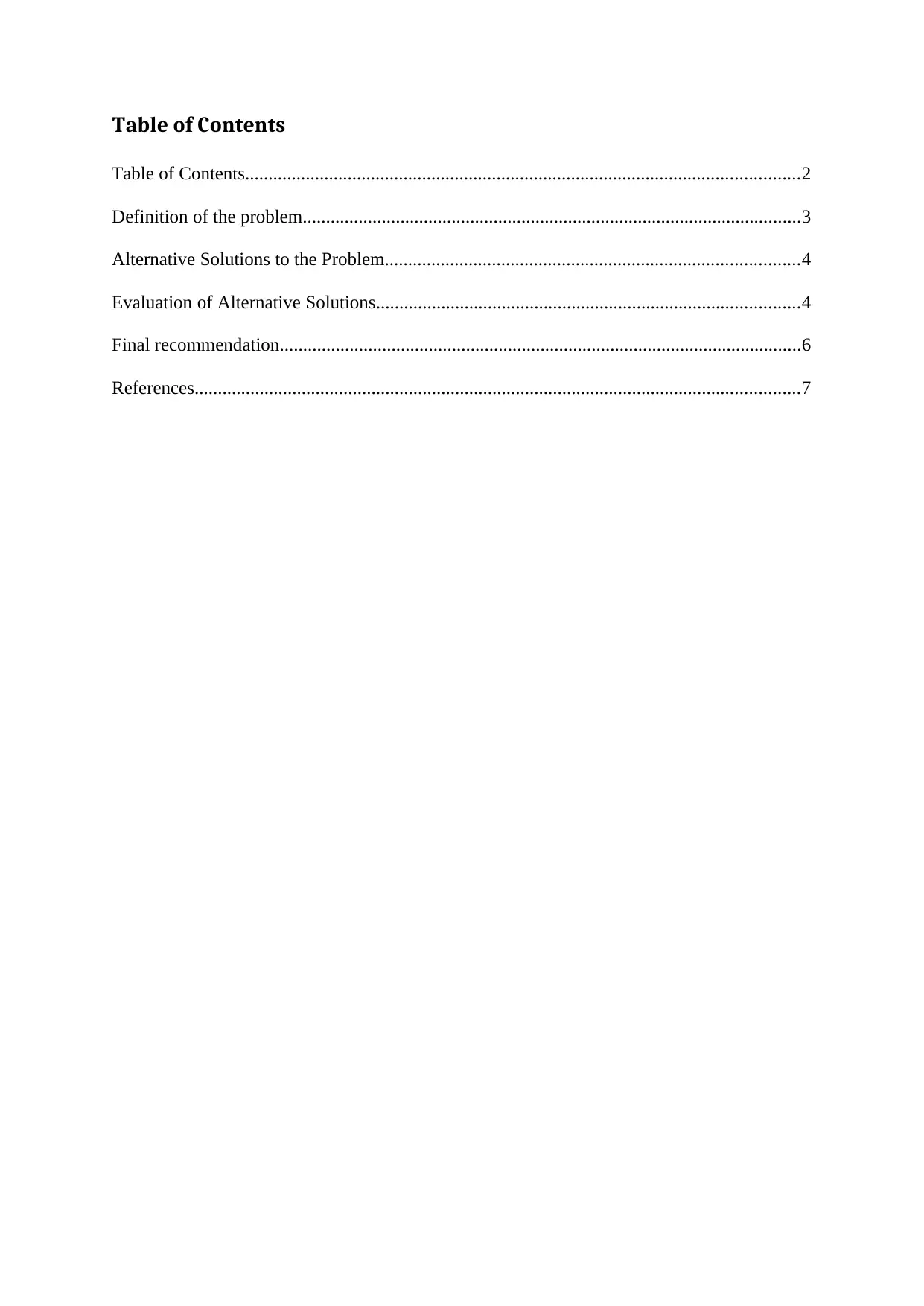
Table of Contents
Table of Contents.......................................................................................................................2
Definition of the problem...........................................................................................................3
Alternative Solutions to the Problem.........................................................................................4
Evaluation of Alternative Solutions...........................................................................................4
Final recommendation................................................................................................................6
References..................................................................................................................................7
Table of Contents.......................................................................................................................2
Definition of the problem...........................................................................................................3
Alternative Solutions to the Problem.........................................................................................4
Evaluation of Alternative Solutions...........................................................................................4
Final recommendation................................................................................................................6
References..................................................................................................................................7
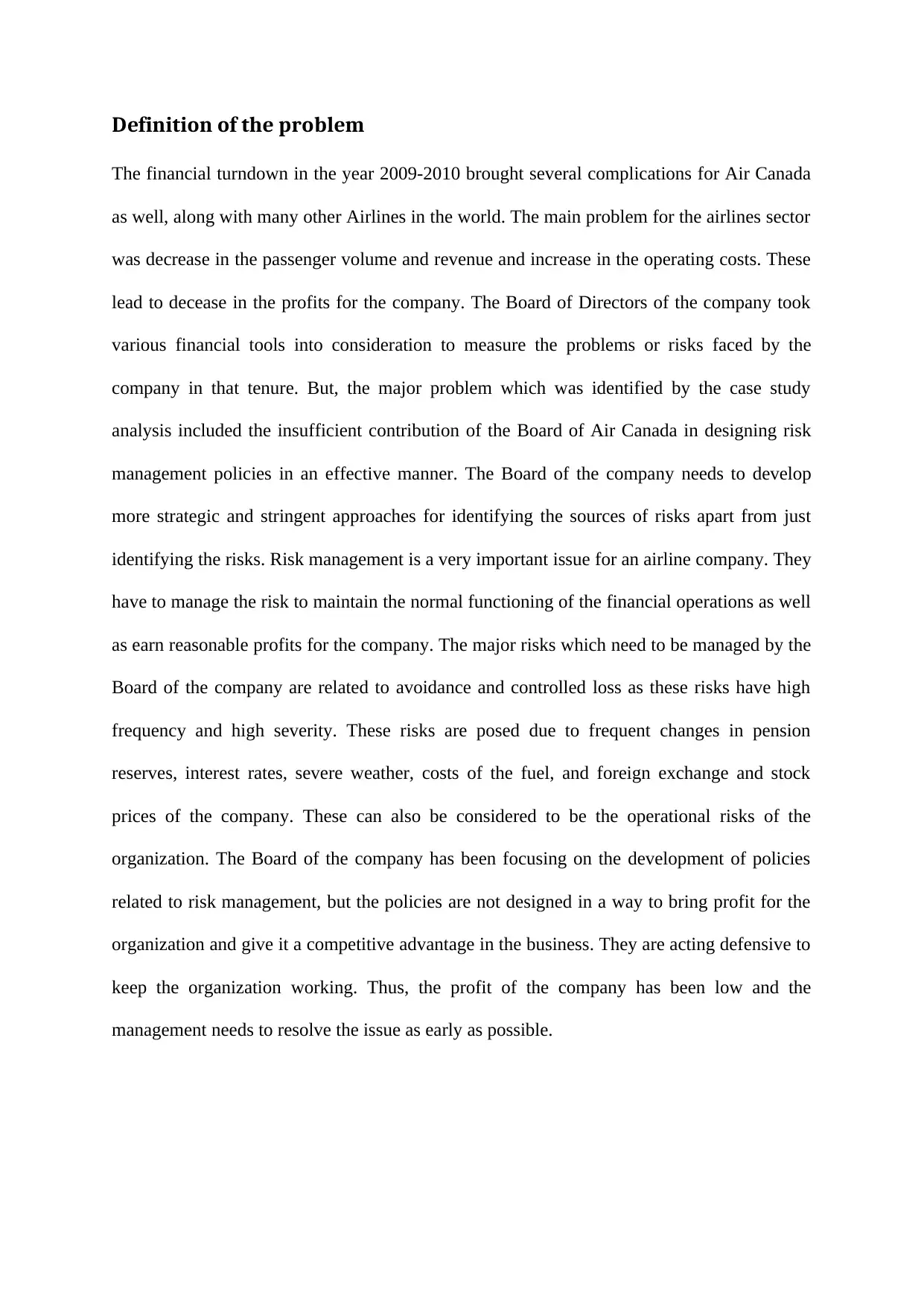
Definition of the problem
The financial turndown in the year 2009-2010 brought several complications for Air Canada
as well, along with many other Airlines in the world. The main problem for the airlines sector
was decrease in the passenger volume and revenue and increase in the operating costs. These
lead to decease in the profits for the company. The Board of Directors of the company took
various financial tools into consideration to measure the problems or risks faced by the
company in that tenure. But, the major problem which was identified by the case study
analysis included the insufficient contribution of the Board of Air Canada in designing risk
management policies in an effective manner. The Board of the company needs to develop
more strategic and stringent approaches for identifying the sources of risks apart from just
identifying the risks. Risk management is a very important issue for an airline company. They
have to manage the risk to maintain the normal functioning of the financial operations as well
as earn reasonable profits for the company. The major risks which need to be managed by the
Board of the company are related to avoidance and controlled loss as these risks have high
frequency and high severity. These risks are posed due to frequent changes in pension
reserves, interest rates, severe weather, costs of the fuel, and foreign exchange and stock
prices of the company. These can also be considered to be the operational risks of the
organization. The Board of the company has been focusing on the development of policies
related to risk management, but the policies are not designed in a way to bring profit for the
organization and give it a competitive advantage in the business. They are acting defensive to
keep the organization working. Thus, the profit of the company has been low and the
management needs to resolve the issue as early as possible.
The financial turndown in the year 2009-2010 brought several complications for Air Canada
as well, along with many other Airlines in the world. The main problem for the airlines sector
was decrease in the passenger volume and revenue and increase in the operating costs. These
lead to decease in the profits for the company. The Board of Directors of the company took
various financial tools into consideration to measure the problems or risks faced by the
company in that tenure. But, the major problem which was identified by the case study
analysis included the insufficient contribution of the Board of Air Canada in designing risk
management policies in an effective manner. The Board of the company needs to develop
more strategic and stringent approaches for identifying the sources of risks apart from just
identifying the risks. Risk management is a very important issue for an airline company. They
have to manage the risk to maintain the normal functioning of the financial operations as well
as earn reasonable profits for the company. The major risks which need to be managed by the
Board of the company are related to avoidance and controlled loss as these risks have high
frequency and high severity. These risks are posed due to frequent changes in pension
reserves, interest rates, severe weather, costs of the fuel, and foreign exchange and stock
prices of the company. These can also be considered to be the operational risks of the
organization. The Board of the company has been focusing on the development of policies
related to risk management, but the policies are not designed in a way to bring profit for the
organization and give it a competitive advantage in the business. They are acting defensive to
keep the organization working. Thus, the profit of the company has been low and the
management needs to resolve the issue as early as possible.
⊘ This is a preview!⊘
Do you want full access?
Subscribe today to unlock all pages.

Trusted by 1+ million students worldwide
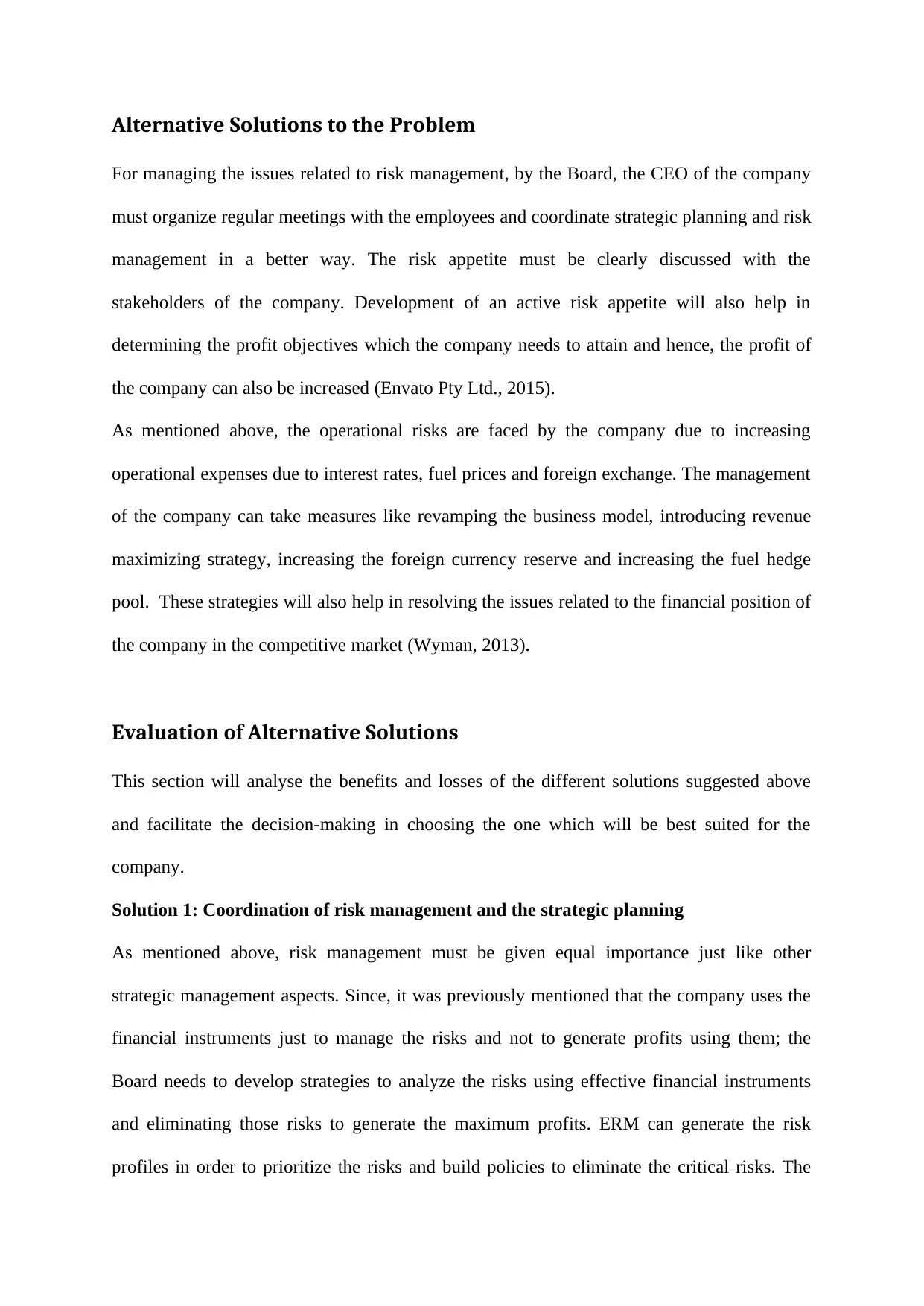
Alternative Solutions to the Problem
For managing the issues related to risk management, by the Board, the CEO of the company
must organize regular meetings with the employees and coordinate strategic planning and risk
management in a better way. The risk appetite must be clearly discussed with the
stakeholders of the company. Development of an active risk appetite will also help in
determining the profit objectives which the company needs to attain and hence, the profit of
the company can also be increased (Envato Pty Ltd., 2015).
As mentioned above, the operational risks are faced by the company due to increasing
operational expenses due to interest rates, fuel prices and foreign exchange. The management
of the company can take measures like revamping the business model, introducing revenue
maximizing strategy, increasing the foreign currency reserve and increasing the fuel hedge
pool. These strategies will also help in resolving the issues related to the financial position of
the company in the competitive market (Wyman, 2013).
Evaluation of Alternative Solutions
This section will analyse the benefits and losses of the different solutions suggested above
and facilitate the decision-making in choosing the one which will be best suited for the
company.
Solution 1: Coordination of risk management and the strategic planning
As mentioned above, risk management must be given equal importance just like other
strategic management aspects. Since, it was previously mentioned that the company uses the
financial instruments just to manage the risks and not to generate profits using them; the
Board needs to develop strategies to analyze the risks using effective financial instruments
and eliminating those risks to generate the maximum profits. ERM can generate the risk
profiles in order to prioritize the risks and build policies to eliminate the critical risks. The
For managing the issues related to risk management, by the Board, the CEO of the company
must organize regular meetings with the employees and coordinate strategic planning and risk
management in a better way. The risk appetite must be clearly discussed with the
stakeholders of the company. Development of an active risk appetite will also help in
determining the profit objectives which the company needs to attain and hence, the profit of
the company can also be increased (Envato Pty Ltd., 2015).
As mentioned above, the operational risks are faced by the company due to increasing
operational expenses due to interest rates, fuel prices and foreign exchange. The management
of the company can take measures like revamping the business model, introducing revenue
maximizing strategy, increasing the foreign currency reserve and increasing the fuel hedge
pool. These strategies will also help in resolving the issues related to the financial position of
the company in the competitive market (Wyman, 2013).
Evaluation of Alternative Solutions
This section will analyse the benefits and losses of the different solutions suggested above
and facilitate the decision-making in choosing the one which will be best suited for the
company.
Solution 1: Coordination of risk management and the strategic planning
As mentioned above, risk management must be given equal importance just like other
strategic management aspects. Since, it was previously mentioned that the company uses the
financial instruments just to manage the risks and not to generate profits using them; the
Board needs to develop strategies to analyze the risks using effective financial instruments
and eliminating those risks to generate the maximum profits. ERM can generate the risk
profiles in order to prioritize the risks and build policies to eliminate the critical risks. The
Paraphrase This Document
Need a fresh take? Get an instant paraphrase of this document with our AI Paraphraser
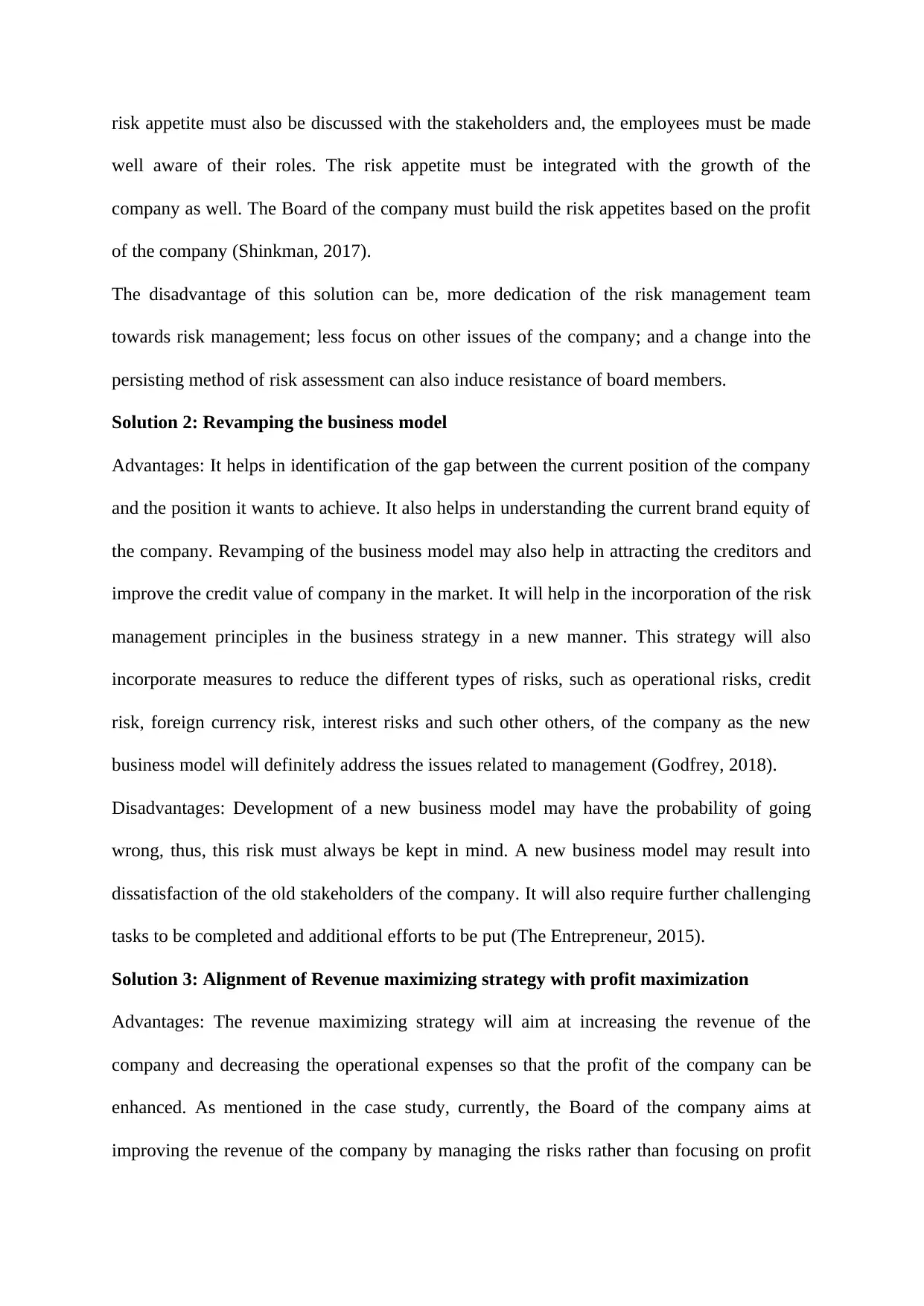
risk appetite must also be discussed with the stakeholders and, the employees must be made
well aware of their roles. The risk appetite must be integrated with the growth of the
company as well. The Board of the company must build the risk appetites based on the profit
of the company (Shinkman, 2017).
The disadvantage of this solution can be, more dedication of the risk management team
towards risk management; less focus on other issues of the company; and a change into the
persisting method of risk assessment can also induce resistance of board members.
Solution 2: Revamping the business model
Advantages: It helps in identification of the gap between the current position of the company
and the position it wants to achieve. It also helps in understanding the current brand equity of
the company. Revamping of the business model may also help in attracting the creditors and
improve the credit value of company in the market. It will help in the incorporation of the risk
management principles in the business strategy in a new manner. This strategy will also
incorporate measures to reduce the different types of risks, such as operational risks, credit
risk, foreign currency risk, interest risks and such other others, of the company as the new
business model will definitely address the issues related to management (Godfrey, 2018).
Disadvantages: Development of a new business model may have the probability of going
wrong, thus, this risk must always be kept in mind. A new business model may result into
dissatisfaction of the old stakeholders of the company. It will also require further challenging
tasks to be completed and additional efforts to be put (The Entrepreneur, 2015).
Solution 3: Alignment of Revenue maximizing strategy with profit maximization
Advantages: The revenue maximizing strategy will aim at increasing the revenue of the
company and decreasing the operational expenses so that the profit of the company can be
enhanced. As mentioned in the case study, currently, the Board of the company aims at
improving the revenue of the company by managing the risks rather than focusing on profit
well aware of their roles. The risk appetite must be integrated with the growth of the
company as well. The Board of the company must build the risk appetites based on the profit
of the company (Shinkman, 2017).
The disadvantage of this solution can be, more dedication of the risk management team
towards risk management; less focus on other issues of the company; and a change into the
persisting method of risk assessment can also induce resistance of board members.
Solution 2: Revamping the business model
Advantages: It helps in identification of the gap between the current position of the company
and the position it wants to achieve. It also helps in understanding the current brand equity of
the company. Revamping of the business model may also help in attracting the creditors and
improve the credit value of company in the market. It will help in the incorporation of the risk
management principles in the business strategy in a new manner. This strategy will also
incorporate measures to reduce the different types of risks, such as operational risks, credit
risk, foreign currency risk, interest risks and such other others, of the company as the new
business model will definitely address the issues related to management (Godfrey, 2018).
Disadvantages: Development of a new business model may have the probability of going
wrong, thus, this risk must always be kept in mind. A new business model may result into
dissatisfaction of the old stakeholders of the company. It will also require further challenging
tasks to be completed and additional efforts to be put (The Entrepreneur, 2015).
Solution 3: Alignment of Revenue maximizing strategy with profit maximization
Advantages: The revenue maximizing strategy will aim at increasing the revenue of the
company and decreasing the operational expenses so that the profit of the company can be
enhanced. As mentioned in the case study, currently, the Board of the company aims at
improving the revenue of the company by managing the risks rather than focusing on profit
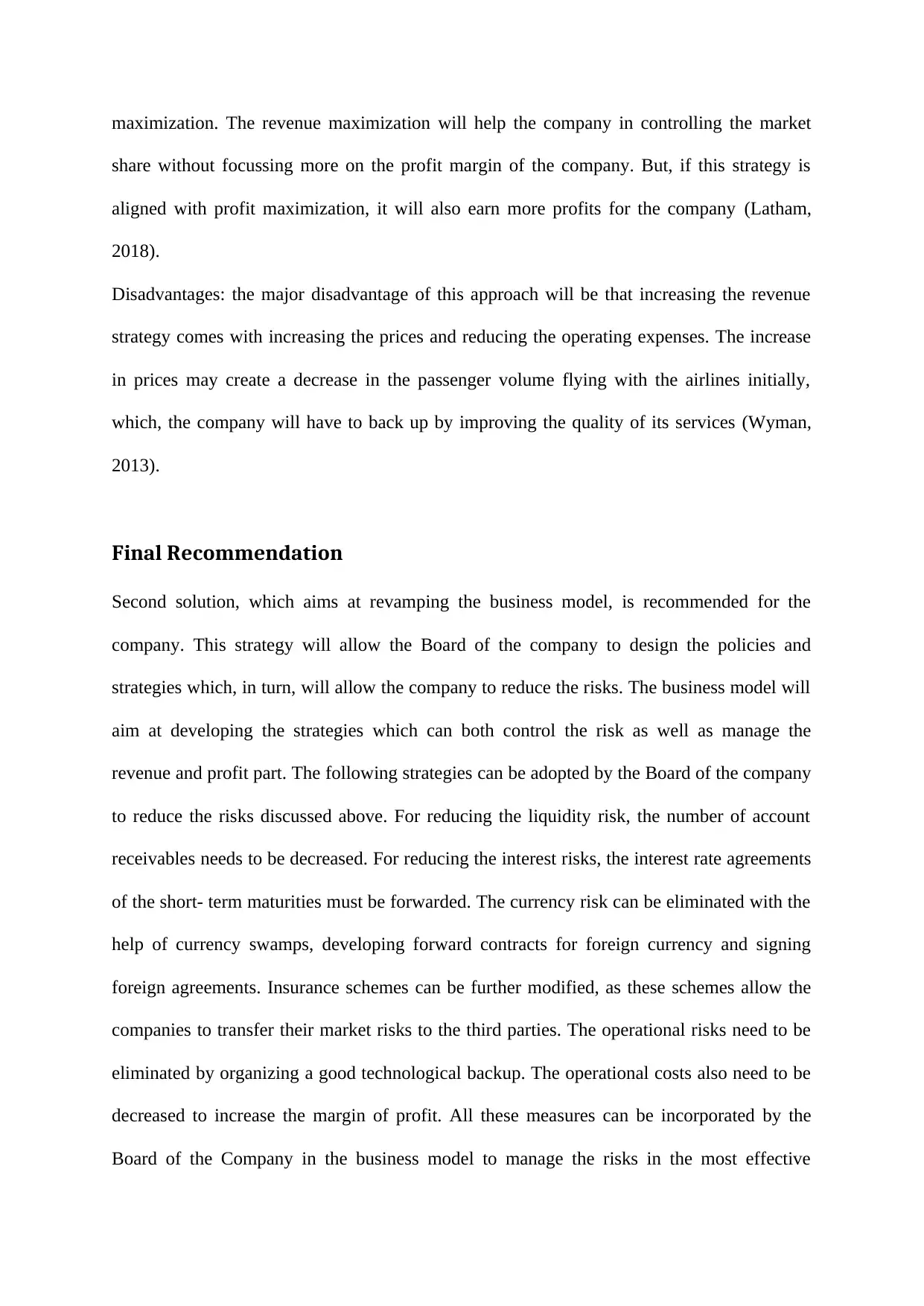
maximization. The revenue maximization will help the company in controlling the market
share without focussing more on the profit margin of the company. But, if this strategy is
aligned with profit maximization, it will also earn more profits for the company (Latham,
2018).
Disadvantages: the major disadvantage of this approach will be that increasing the revenue
strategy comes with increasing the prices and reducing the operating expenses. The increase
in prices may create a decrease in the passenger volume flying with the airlines initially,
which, the company will have to back up by improving the quality of its services (Wyman,
2013).
Final Recommendation
Second solution, which aims at revamping the business model, is recommended for the
company. This strategy will allow the Board of the company to design the policies and
strategies which, in turn, will allow the company to reduce the risks. The business model will
aim at developing the strategies which can both control the risk as well as manage the
revenue and profit part. The following strategies can be adopted by the Board of the company
to reduce the risks discussed above. For reducing the liquidity risk, the number of account
receivables needs to be decreased. For reducing the interest risks, the interest rate agreements
of the short- term maturities must be forwarded. The currency risk can be eliminated with the
help of currency swamps, developing forward contracts for foreign currency and signing
foreign agreements. Insurance schemes can be further modified, as these schemes allow the
companies to transfer their market risks to the third parties. The operational risks need to be
eliminated by organizing a good technological backup. The operational costs also need to be
decreased to increase the margin of profit. All these measures can be incorporated by the
Board of the Company in the business model to manage the risks in the most effective
share without focussing more on the profit margin of the company. But, if this strategy is
aligned with profit maximization, it will also earn more profits for the company (Latham,
2018).
Disadvantages: the major disadvantage of this approach will be that increasing the revenue
strategy comes with increasing the prices and reducing the operating expenses. The increase
in prices may create a decrease in the passenger volume flying with the airlines initially,
which, the company will have to back up by improving the quality of its services (Wyman,
2013).
Final Recommendation
Second solution, which aims at revamping the business model, is recommended for the
company. This strategy will allow the Board of the company to design the policies and
strategies which, in turn, will allow the company to reduce the risks. The business model will
aim at developing the strategies which can both control the risk as well as manage the
revenue and profit part. The following strategies can be adopted by the Board of the company
to reduce the risks discussed above. For reducing the liquidity risk, the number of account
receivables needs to be decreased. For reducing the interest risks, the interest rate agreements
of the short- term maturities must be forwarded. The currency risk can be eliminated with the
help of currency swamps, developing forward contracts for foreign currency and signing
foreign agreements. Insurance schemes can be further modified, as these schemes allow the
companies to transfer their market risks to the third parties. The operational risks need to be
eliminated by organizing a good technological backup. The operational costs also need to be
decreased to increase the margin of profit. All these measures can be incorporated by the
Board of the Company in the business model to manage the risks in the most effective
⊘ This is a preview!⊘
Do you want full access?
Subscribe today to unlock all pages.

Trusted by 1+ million students worldwide
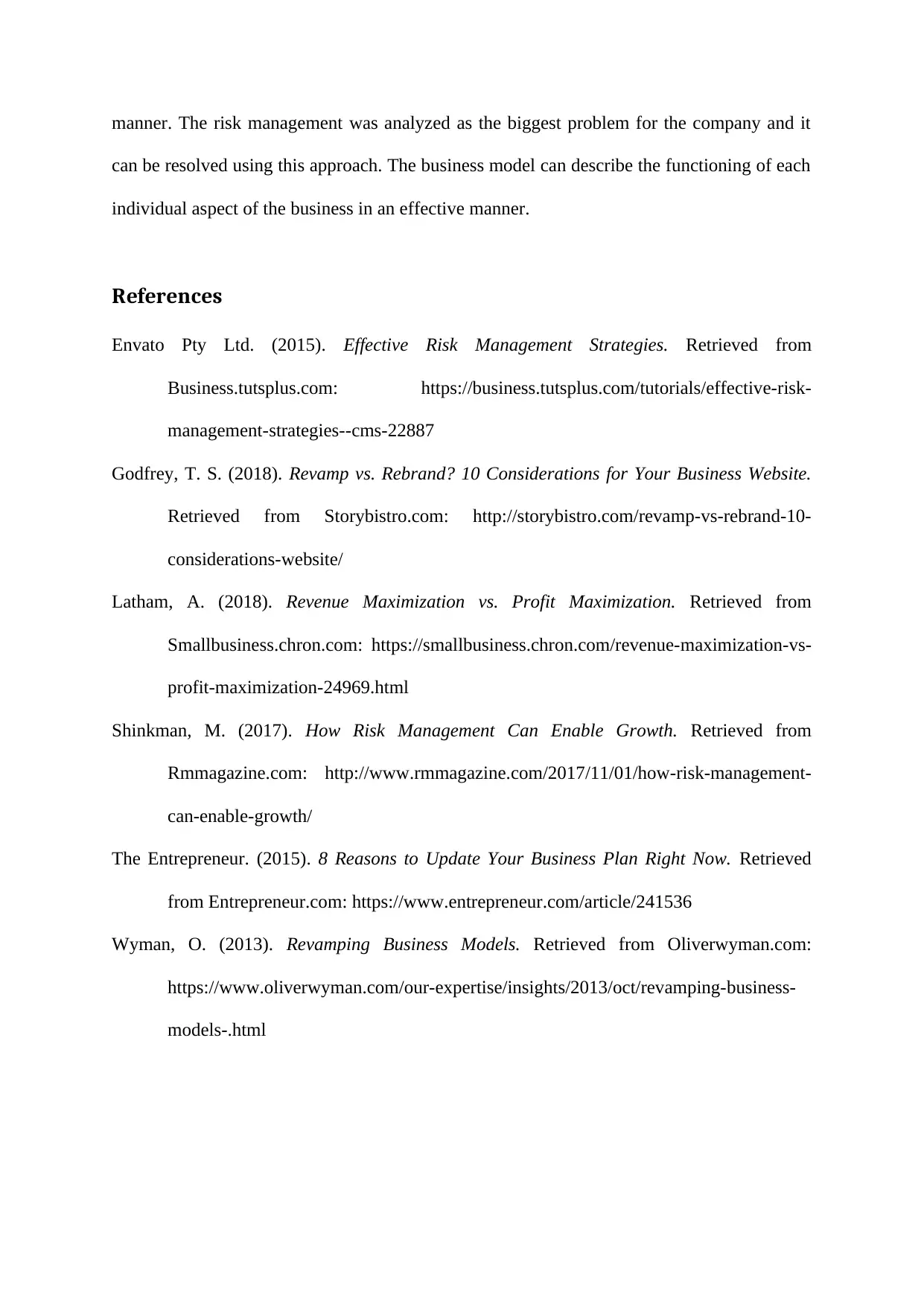
manner. The risk management was analyzed as the biggest problem for the company and it
can be resolved using this approach. The business model can describe the functioning of each
individual aspect of the business in an effective manner.
References
Envato Pty Ltd. (2015). Effective Risk Management Strategies. Retrieved from
Business.tutsplus.com: https://business.tutsplus.com/tutorials/effective-risk-
management-strategies--cms-22887
Godfrey, T. S. (2018). Revamp vs. Rebrand? 10 Considerations for Your Business Website.
Retrieved from Storybistro.com: http://storybistro.com/revamp-vs-rebrand-10-
considerations-website/
Latham, A. (2018). Revenue Maximization vs. Profit Maximization. Retrieved from
Smallbusiness.chron.com: https://smallbusiness.chron.com/revenue-maximization-vs-
profit-maximization-24969.html
Shinkman, M. (2017). How Risk Management Can Enable Growth. Retrieved from
Rmmagazine.com: http://www.rmmagazine.com/2017/11/01/how-risk-management-
can-enable-growth/
The Entrepreneur. (2015). 8 Reasons to Update Your Business Plan Right Now. Retrieved
from Entrepreneur.com: https://www.entrepreneur.com/article/241536
Wyman, O. (2013). Revamping Business Models. Retrieved from Oliverwyman.com:
https://www.oliverwyman.com/our-expertise/insights/2013/oct/revamping-business-
models-.html
can be resolved using this approach. The business model can describe the functioning of each
individual aspect of the business in an effective manner.
References
Envato Pty Ltd. (2015). Effective Risk Management Strategies. Retrieved from
Business.tutsplus.com: https://business.tutsplus.com/tutorials/effective-risk-
management-strategies--cms-22887
Godfrey, T. S. (2018). Revamp vs. Rebrand? 10 Considerations for Your Business Website.
Retrieved from Storybistro.com: http://storybistro.com/revamp-vs-rebrand-10-
considerations-website/
Latham, A. (2018). Revenue Maximization vs. Profit Maximization. Retrieved from
Smallbusiness.chron.com: https://smallbusiness.chron.com/revenue-maximization-vs-
profit-maximization-24969.html
Shinkman, M. (2017). How Risk Management Can Enable Growth. Retrieved from
Rmmagazine.com: http://www.rmmagazine.com/2017/11/01/how-risk-management-
can-enable-growth/
The Entrepreneur. (2015). 8 Reasons to Update Your Business Plan Right Now. Retrieved
from Entrepreneur.com: https://www.entrepreneur.com/article/241536
Wyman, O. (2013). Revamping Business Models. Retrieved from Oliverwyman.com:
https://www.oliverwyman.com/our-expertise/insights/2013/oct/revamping-business-
models-.html
1 out of 7
Related Documents
Your All-in-One AI-Powered Toolkit for Academic Success.
+13062052269
info@desklib.com
Available 24*7 on WhatsApp / Email
![[object Object]](/_next/static/media/star-bottom.7253800d.svg)
Unlock your academic potential
Copyright © 2020–2025 A2Z Services. All Rights Reserved. Developed and managed by ZUCOL.




